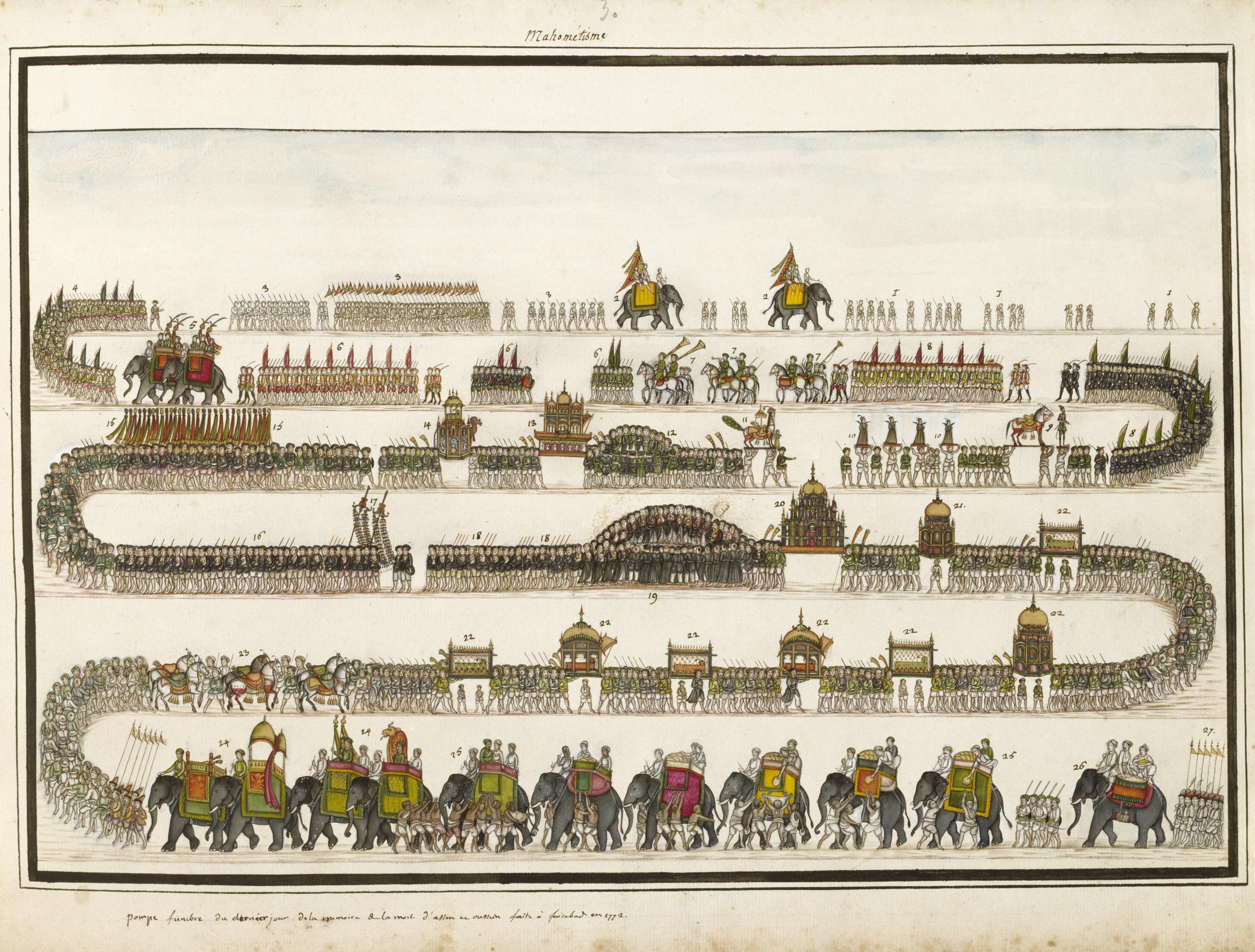Dr.Mazhar Naqvi
The Alividai (Farewell) procession of Anjuman Ghuncha Raza-E-Islam is gaining popularity with each successive year following innovations in the decoration of Alams,Tabut,Zuljana, Jhula and portrayal of scenes from battle of Karbala. Taken out on 7th Rabi- Ul- Awal to mark the end of Ayam-E-Aza in Kanpur City, the procession this year witnessed Alams made of dry fruits and flowers away from traditional Sehras. While one Alam perhaps for the first time in India displayed severed hands of Hazrat Abbas, the second Alam had a floral Amama like Sehra not yet seen in any procession in and around Kanpur.Members of Anjuman depicted scenes of Karbala battle on a vraised platform near the culinating point of the procession Mehdi Hall at Chota Phatak.The table had on display Nahar-E-Furat, Khema Gaah-E-Hussaini,Maqtal, Ganj-E-Shaeedan, tiny grave of Hazrat Ali Asghar, Alams and Amaris of aseeran-E-Karbala. So meticulously each scene was prepared that devotees formed beeline to have a glimpse of the portrayal and described the effort as a fine example of creativity.

Zuljana of the Procession
omen wept bitterly when they saw the severed hands on the Alam and tastefully decorated Zunjinah accompanying it in a somber manner.

Zuljana of the Procession
Being the last procession of Ayam-E-Aza,people from far flung places reached Nawab Sahib Ka Hata to participate.The procession originated from Imambara of Haider Sahib near Baghwali Masjid. Prior to it, Ashiq-e-Hussain under the age of seven recited Kalams abut martyrs of Karbala. Prominent among them included Ali, Qaim Mehdi, Mohsin and Abbas.The,Khateeb -E-Ahlebait Janab Talib Hussain Talib recited masaib of Aseeran-e-Karbala and also paid his tributes to martyrdom of Hazrat Imam Hasan Askari.

A Beautifully Created Scene of Nahar-E-Alqama
After passing through its traditional routes,the procession culminated at Mehdi Hall.Enroute Anjuman-E-Rizviya recited its famous 'Rukhsat'written by Shair -E-Ahlebait Marhoom Baqar Tabatabai.Nawab Mumtaz ,Ibne Hasan Zaidi, Masroor,Wasi and Raja rendered Rukhsat in a heart-touching manner.Then, Anjuman-Moin-Ul-Momneen bid farewell to 68-days long Muharram mourning by presenting its famous Alvida.Jafar Qazim and Pappi recited Mere Ghareeb Alvida,Mere Ghareeb Alvida.Maulana Rais Ahmad Jarchvi addressed the majlis held on occasion and he criticized severely those trying to break unity among Muslims.he urged people to follow the path of Imam Hussain to get resolved all their worldly and spiritual problems.

A Beautifully Created Scene of Nahar-E-Alqama
After passing through its traditional routes,the procession culminated at Mehdi Hall.Enroute Anjuman-E-Rizviya recited its famous 'Rukhsat'written by Shair -E-Ahlebait Marhoom Baqar Tabatabai.Nawab Mumtaz ,Ibne Hasan Zaidi, Masroor,Wasi and Raja rendered Rukhsat in a heart-touching manner.Then, Anjuman-Moin-Ul-Momneen bid farewell to 68-days long Muharram mourning by presenting its famous Alvida.Jafar Qazim and Pappi recited Mere Ghareeb Alvida,Mere Ghareeb Alvida.Maulana Rais Ahmad Jarchvi addressed the majlis held on occasion and he criticized severely those trying to break unity among Muslims.he urged people to follow the path of Imam Hussain to get resolved all their worldly and spiritual problems.
The procession was started by children of Hata at the instance of promient zakira Ahlebait Mohtarma dr.Hena Zaheer Sahiba about a decade ago.Since then, it has emerged as a popular procession and know for its creative presentation of constituents of Muharram procession.Another unique feature of the program is handing over of 'Taburrukats' to women devotees after the Mardani Majlis. Then,women perform Seenazani for hours after the address of Mohtarma Hena Zaheer who describes the plight of Aseeran-e-Karbala and Imam Hasan Askari in a heart-rending manner.
The committee that made all the arrangements are all very young.The spirited brigade make preparations for almost a month for the procession under the guidance of artist Janab Romin Sahib.The dedicated lot includes Guddu, Murphy, Shauzaf, Faizi Haider,Nadeem,Harris,Talib,Shanu,Khizr,Azmi,Monu,Shuja and Minal.(Article is based on the personal participation of the blogger and photos were also taken by him).











![Bainazir Palace [Rampur]](http://ogimages.bl.uk/images/019/019PHO000000036U00050000[SVC1].jpg)
